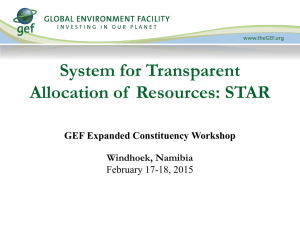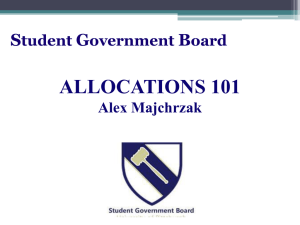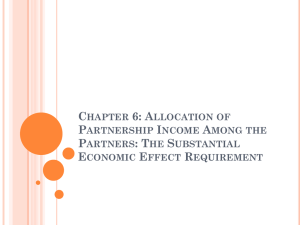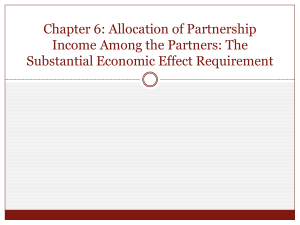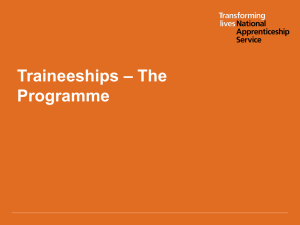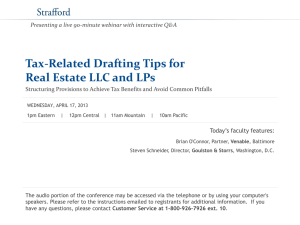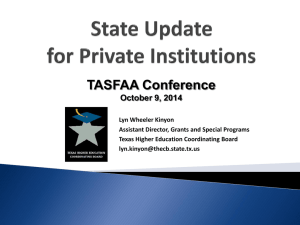EFA Briefing - Jan`14 - Northumbria Learning Providers
advertisement
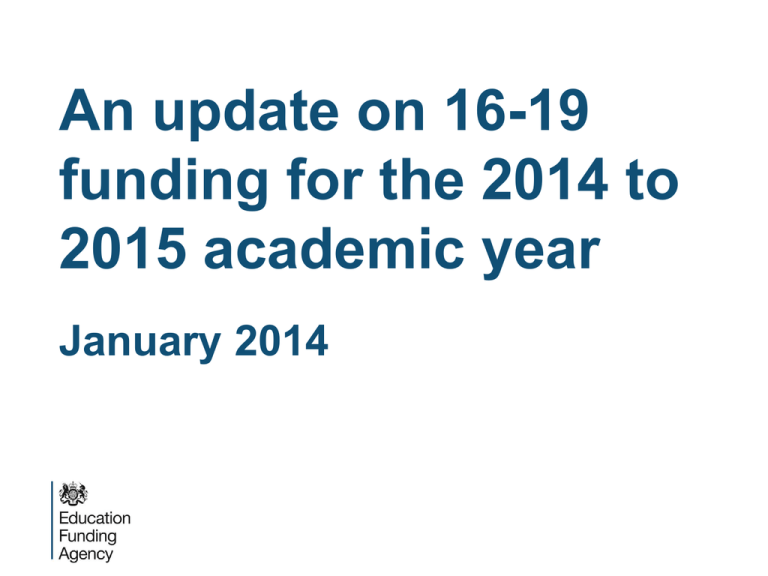
An update on 16-19 funding for the 2014 to 2015 academic year January 2014 Agenda Welcome and introduction Session 1 - Areas where funding policy is changing Session 2 - Funding per student update Session 3 - 16-19 Allocations for 2014 to 2015 Session 4 - High needs funding Northern Territory – 2011 to 2013 Population Change and Funded Places England NE NW Y&H North 10,000 5,000 -5,000 -10,000 -15,000 -20,000 -25,000 -30,000 Population 2011 to 2013 Funded Places 2011 to 2013 Useful Documents Funding formula review http://www.education.gov.uk/aboutdfe/executiveagencies/efa/a00210682/fun ding-formula-review Funding guidance https://media.education.gov.uk/assets/files/pdf/f/funding%20review%20june %2013%20v4.pdf ( The funding formula Student Numbers National Funding Rate per student Retention Factor Programme Cost Weighting Total Programme Funding Disadvantage Funding ) Area Cost Allowance ……plus extras (if applicable) ( Student Numbers National Funding Rate per student Retention Factor Programme Cost Weighting Disadvantage Funding ) Total Programme Funding TP from 11/12 Formula Protection Funding High Needs Students Student Support Funding Area Cost Allowance 2014 to 2015 Areas where funding policy is changing Funding of 18 year olds Band Study programme hours and ages 5 Full time 16/17 year olds doing 540 hours or more 4 Full time for 18 year olds and 16/17 year olds doing between 450 and 539 hours 3 Between 360 and 449 hours 2 Between 280 and 359 hours 1 Less than 280 hours Students who are 18 or over at 31st August preceding the start of the academic year New for 2014/15 Formula protection funding (FPF) FPF was introduced for 2013 to 14 to be paid for at least three academic years, until and including 2015/16 For 2014 to 15 it will: Reduce from any gains in the formula – e.g. where the value of the formula increases due to improved retention, more students attracting disadvantage, increased programme size, for example FPF will reduce Stay the same if the value of the formula reduces Should the value of the formula exceed the funding per student paid in 2012 to 13 then the formula, net of FPF, is paid in full New for 2014/15 Formula Protection Funding £4,500 £500 £4,300 £500 £3,800 Formula down FPF the same Funding per student reduces 12/13 13/14 14/15 Formula Protection Funding £4700 £4,500 £4,700 per student from the formula £500 £4,000 12/13 13/14 14/15 Programme cost weightings The review of Programme Cost Weighting is now completed and has been considered by Ministers There will be no changes to these weightings for 2014 to15 We will keep the weightings under review and consider whether to make changes after 2015 to 16 Funding per student update Planned hours eligible for funding Relevant • Directly relevant to the study programme Planned • Explicit in the Learning Plan or Timetable Supervised • Hours that are supervised and/or organised by the institution Quality Assured • Hours that are quality assured by the institution Normal Working Pattern • Hours that are within an institution’s normal working pattern Study Leave • Where it meets the criteria set out above, is time limited and the weekly hours do not exceed the student’s planned weekly hours for the overall study programme Hours that do not count for funding Voluntary Homework • Voluntary extra-curricular activities and clubs delivered during breaks or outside normal working pattern • Study that is homework or independent study/research that is not timetabled Employment • Employment or work experience organised by anyone other than by or on behalf of the provider Volunteering • Volunteering or community activities that are not organised by or on behalf of the provider Recording planned hours for funding purposes Qualification Hours Non Qualification Hours • Hours that are delivered towards qualifications that are approved for teaching to 16-19 year olds under section 96 of the Learning and Skills Act 2000 • Do not count towards a qualification on section 96 • Informal Certificates • Non-qualification activity • Tutorial activity • Work experience/Work related activity • Volunteering/Community activities • Enrichment activities Core Aims Changing a core aim is a significant change to a student’s programme that should not be taken lightly. We would expect the vast majority of students will have a finalised core aim, (vocational qualification or work experience) within 12 weeks of starting. Condensed delivery Where institutions condense delivery into a significant number of hours over a short period of time, we would expect this to lead to excellent results, as demonstrated through qualification success rates and positive destinations for young people. We will monitor the delivery and value for money of compressed programmes during 2013 to14. Work experience-developments From 2014 to15 the way non-qualification activity is recorded will change Work Experience will need to have taken place within an EXTERNAL employers’ workplace Simulated work environments should be separately recorded as non-qualification activity Institutions/providers need to put arrangements in place to achieve this during 2013 to14 Activity in, for example, a college crèche or restaurant would not count as external work experience Retakes For a transitional year in 2013 to 14 the planned hours for students repeating activity studied in 2012/13 can be counted Students starting in 2014 to 15 onwards, re-takes will not generally be eligible for funding unless there are exceptional circumstances outside the control of the student or institution (e.g. a period of long term sickness or other good educational reason) NEW FOR 2014/15 ACTION FOR 2014/15 19 English and Maths condition of funding From September 2013, students who do not hold an A*-C in English or maths will need to continue to study towards this through: GCSE/iGCSE, or Functional Skills, Free Standing Maths or ESOL qualifications as stepping stones to GCSE. This is a condition of funding from the next academic year. This means any student recruited from 1 August 2014 without at least a GCSE grade C in these subjects and not registered to work towards this level will not be counted for your funding allocation for 2016 to17 Students entering post-16 education with a grade D GCSE in English and/or maths will be expected to be enrolled on a GCSE course Enrolments in 2014 to 15 will have a direct impact on funding in 2016 to 17 allocations ACTION FOR 2014/15 LLDD and maths/English Students with learning difficulties and/or disabilities (LDD) who are capable of taking and achieving maths and English qualifications should do so, studying to the appropriate level Some students with complex LDD might be better served by other types of English and maths teaching and may be exempt from the funding condition where appropriate – this will depend on the student’s initial assessment ACTION FOR 2014/15 Traineeships are for 16-18 year olds and are unique compared to other study programmes as work experience is the core aim Traineeships will always involve a placement with an employee About 250 EFA-funded providers are currently involved Coverage across the country sufficient so far, and we are monitoring various aspects such as geographical coverage No funding changes for 2014 to 15 List of eligible providers and joint question and answer document published on SFA website at this link: http://readingroom.skillsfundingagency.bis.gov.uk/sfa/EFA_SFA_eli gibility_traineeships_19_08_13_V2_Final_Published.zip The list will be updated in February and May ‘14 The list contains links to the framework document on traineeships and both agencies funding rules 22 Challenges for the future: Achieving a good geographical coverage; Growing the number of traineeships by organic growth and by more Ofsted grade 1 and 2 providers taking up the opportunity to deliver traineeships (a condition remaining in place for 2014 to15); Ensuring traineeships remains a high quality programme and brand; Looking ahead and preparing for 2015 to16 23 16-19 Allocations: 2014 to 2015 Allocations Process - Overview Lagged process as for 2013/14 Introducing a more phased approach – so we will send data on funding elements out as it becomes available Only limited phasing is possible for March allocations as it is a single formula and budget, but timing will reflect the increased importance of February student number data for FE allocations Timeline Key Dates for 2014 to 2015 allocations (CCPs): Date Event December Send out FE funding factors based on 2012/13 data R04 (2013/14) data close January 2014 Deadline for business cases on funding factors February R06 (2013/14) data close March Confirm lagged numbers based on R06 EFA confirms national rate Send out FE allocations Lagged Student Numbers CCPs Twelve month rolling figure from February 2013 to January 2014 Based on R06 (13/14) and R14 (12/13) – carry-in as at 1 Feb 2013 and starts from 1 Feb 2013 to 31 Jan 2014 Data Sources ILR R04 December 2013 and/or R06 February 2014 for: Lagged student numbers – how many students will be funded ILR R14 October 2013 for: Programme Size (Full-time/part-time) Funding factors – retention, programme cost weighting, disadvantage block 1 (economic disadvantage) These factors determine the level of funding per student YP Matched Administrative Data, 2011/12 for: Disadvantage block 2 (GCSE English and maths grades) (DN: may also be used for bursaries) Affects the level of funding per student Programme size Calculated based on 2012/13 data for the proportion of students in each band 16- and 17-year olds in bands 4 & 5 in the 2012/13 data will be treated as band 5 for the 2014/15 allocation 18-year olds in bands 4 & 5 in the 2012/13 data will be treated as band 4 for the 2014/15 allocation The rate for band 4 will be 82.5% of the rate for the band 5 Note: 18-year olds with an LDA (high cost ALS in 2012/13) are treated in the same way as 16- and 17-year olds Infrastructure Cases Local authority gaps and replacement provision No fixed timeline Where required, we must test the market either through negotiation with existing providers or out to tender Zero-funded Gateway 4 gateways in 2012/13, now closed Zero-funded in 2012/13 or 2013/14 will receive an allocation in 2014/15 dependent on actual recruitment Allocations Toolkit We are updating the allocation statements which show funding factors to include a comparison with the equivalent figure for 2013 to 14, allowing institutions to see whether there are any significant changes year-on-year We will also be producing the allocations toolkit again for 2014 to15 to assist institutions in exploring issues and/or making business cases We will not distribute the toolkit routinely, but will provide it on request Transitional Protection (TP) 2014 to 15 is the last year of the transitional protection from spending review 2010 For most institutions, this continues on the same trajectory as was in place previously - the TP per student in 2014 to 15 will be the 2013 to 14 figure reduced by the higher of 3% of the total £/student or half of the 2013/14 TP per student For those institutions with additional TP for short courses in 2013 to 14, in 2014 to 15 this additional amount will be half the amount it was in 2013 to 14 No TP in 2015 to16 Short Courses The changes made to exclude funding for short courses in 2013 to14 will apply again in 2014 to15 The effects of this are already built into the 2013 to14 allocations, with associated transitional protection, so we do not expect it to have further major impact However, we will review the impact of this issue on allocations for 2014 to 15 to ensure there are no unintended outcomes Sub-contracting EFA will not fund institutions for distance sub-contracting of the whole programme other than in exceptional circumstances Any institutions wishing to be funded for distance sub-contracting in 2014 to15 will need to put a case forward during the allocations process in the spring We expect only a small number of cases to be agreed Currently considering data collection arrangements for subcontracted provision High needs funding in 2014 to 2015 From 2015 to 2016 academic year A lagged system for most places based on the latest available data Flags already included in ILR Flags will be included in the school census from 2014 to 15 There will still be an opportunity for local authorities and institutions to discuss any expected substantial changes to the pattern of provision. 2013 to 2014 academic year We changed the high needs funding system in preparation for the Children & Families Bill and the significant reforms to the SEN system which will come into force from September 2014. Institutions need more stability in place funding and we have clarified that it is not specific to an individual student or local authority. In some cases, placement decisions and contracts have been finalised much later than envisaged. We have played, and continue to play, a supportive role to aid discussions between local authorities and institutions. 2014 to 2015 key changes We will be taking a step towards a lagged system and have designed the process to provide more stability in place funding for institutions. We have encouraged dialogue between local authorities and institutions since we launched the 2014/15 place review process in July 2013. We have shared 2012/13 R14 ILR data with local authorities and requested they take this into account when planning for 2014/15. We know that 2013/14 allocated volumes are not robust in many cases have asked local authorities to declare post 16 2013 to 2014 actuals on their high needs template (HNT) We only expect 2014/15 numbers to deviate from 2013/14 actuals where there are significant changes that LAs know will happen. 2014 to 2015 Key Changes In exceptional circumstances FE institutions, including CCPs, ISPs and NMSS will be able to make a submission for additional place funding in January You will be able to do this where local authorities have failed to take into account the latest actual data from 2012/13 and 2013/14 and there is no clear explanation why Further information on this process, including timings and thresholds, was published on our website in early December – key evidence is data on high needs places in 2013/14 and 2012/13 Academies can make a submission but the timeline is different process commencing after allocation of FAP 2014 to 2015 Timetable On-going dialogue between institutions and local authority regarding place numbers for 2014/15 November: Update to HNTs (high needs templates) for local authorities, including 2012/13 ILR data December 23rd: Local authorities return HNTs and submissions January 17th: Share 2014/15 high needs places with FE, CCPs, NMSS and ISPs January 31st: FE, CCPs, NMSS and ISPs return exceptional submissions February: Confirmation of outcome of local authority and institution submissions March: Final high needs allocations issued to local authorities and institutions Website We have created a new high needs webpage, bringing together information for local authorities and institutions into a single place to improve access http://www.education.gov.uk/aboutdfe/executiveagencies/efa/a0022899 3/hn-funding-information Next steps Regular updates through e-bulletin Factors and lagged student numbers in January Business cases (if applicable) submitted early February Funding rates for 2014 to 15 confirmed in March





